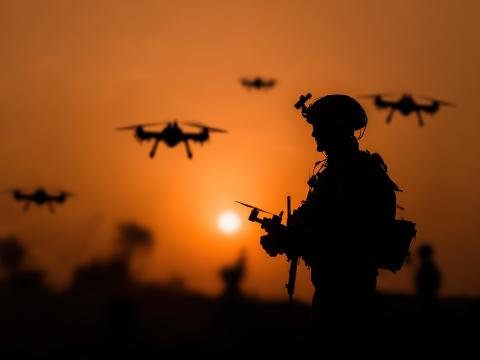Combatant Commands to Host Data Analytics Teams
The U.S. Defense Department is deploying teams of data and artificial intelligence experts to the various combatant commands as part of its efforts to implement the joint all-domain command and control (JADC2) vision. The combatant commands host some teams for relatively short visits—a matter of days—while others will remain onsite for three years.
Kathleen Hicks, deputy secretary of defense, launched the AI and data acceleration (ADA) initiative. The teams include both data and artificial intelligence experts. The chief data officer and the Joint Artificial Intelligence Center (JAIC) coordinate and lead the effort.
“ADA is focused on how we scale data and data-enabling technologies to the combatant commands,” Charleen “Char” Laughlin, JADC2 Division lead and JADC2 deputy cross-functional team lead, Joint Staff, J-6, tells SIGNAL Magazine. “From where I sit now with the Joint Staff, I can tell you that it’s absolutely critical to talk about how we push resources out to the folks who need it most.”
Laughlin explains that the ADA teams are made up of “operational data teams” that will “sit with each of the combatant commands and help the commands work through what their data sources are, what’s authoritative, and how they’re using data in their workflows to enable decision making.”
The artificial intelligence teams are the second component. “These AI teams work with the operational data teams to understand how we can automate the decision workflows—whether it’s in support of a business mission, a logistics mission, a fires mission—in order to really bring advances in technology to bear and help the human out as much as possible by reducing the manually intensive analysis of all of the data coming in and identify the best courses of action for a commander to take,” she elaborates.
The Joint Artificial Intelligence Center creates the artificial intelligence teams, drawing on expertise from a variety of organizations. “They’re fly-away teams, so they will go out, and they’ll visit the combatant commands and then they’ll come back, and they’ll work on developing capabilities,” Laughlin says. That way, she adds, the teams will be able to identify needs across combatant commands and develop solutions for Indo-Pacific Command, for example, that also could work for other commands.
Short-term teams already have visited both Indo-Pacific Command and Northern Command. Brig. Gen. Jacqueline “Denise” Brown, USA, the Indo-Pacific Command’s J-6, or director of command, control, communications and cyber, says in a separate interview that the ADA team arrived in September. The ADA team could help provide the command with processes and capabilities “to help us organize our data to better observe, orient and decide and act,” Gen. Brown says, referring to the so-called OODA loop that describes the combat operations process.
The first two steps of the OODA loop, Gen. Brown notes, are critical for integrating data at the speed of decision making. “As we look at step one, observe, this is our greatest challenge when it comes to integrating data. This is because we have an enormous amount of it. To use it correctly, we have to be able to see our data end-to-end and understand what we have and what data is required for the mission versus what data is noise and not relevant to the mission.”
Following the visits from the initial teams, the Defense Department will establish more permanent three-year teams, some possibly by year’s end. “As part of ADA, over the coming months each of the combatant commands and Joint Staff is scheduled to receive an operational data team of 4-5 folks that will be embedded for approximately three years,” Laughlin offers. “These teams, led by the DoD chief data officer, will support commanders with data management and analytics expertise using several leading platforms. The goal of the deputy secretary’s effort is to get data capabilities into the hands of the warfighter faster.”
Laughlin says her primary focus is “running and executing” the JADC2 Cross-Functional Team. “I would say that my big project is serving as kind of like the engine of the cross-functional team. It’s not glorious, but somebody’s gotta do it,” she jokes before adding, “ I love it.”
She points out she has experience on a variety of cross-functional teams and describes the JADC2 team as “unmatched in scope and scale.”
“It is the widest participation and representation that I have been exposed to in my decade plus in the Department of Defense because it includes all of the components within the Office of the Secretary of Defense, the combatant commands, military services, Defense Information Systems Agency, the Defense Advanced Research Projects Agency, Defense Innovation Unit, and intelligence community organizations such as the National Security Agency, the National Geospatial-Intelligence Agency and the National Reconnaissance Office.
“So, we set a table pretty wide, and we asked everybody to come participate,” Laughlin says.
The cross-functional team is considered an execution arm of the Joint Requirements Oversight Council (JROC). “If requirements change, or priorities change, the services don’t have to go all the way back through the JROC. Instead, they can just come to the cross-functional team to get issues identified and worked out and requirements or capabilities revalidated,” Laughlin says. “I see it as the body that really provides balance, prioritization and acceleration or momentum for all things JADC2. The cross-functional team exposes challenges in culture, acquisition or stovepipes.”
For related content, follow the TechNet Cyber 2021 coverage October 27-28 and read the November issue of SIGNAL Magazine.





Comments